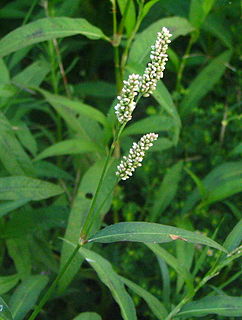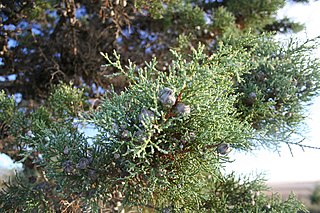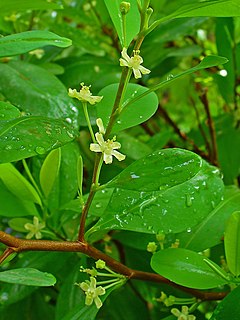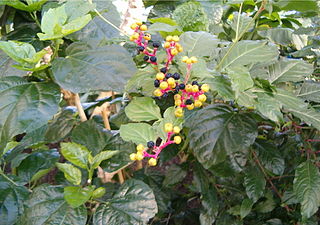
The Ericaceae are a family of flowering plants, commonly known as the heath or heather family, found most commonly in acid and infertile growing conditions. The family is large, with c. 4250 known species spread across 124 genera, making it the 14th most species-rich family of flowering plants. The many well-known and economically important members of the Ericaceae include the cranberry, blueberry, huckleberry, rhododendron, and various common heaths and heathers.

Mentha is a genus of plants in the family Lamiaceae. The exact distinction between species is unclear; it is estimated that 13 to 24 species exist. Hybridization occurs naturally where some species range overlap. Many hybrids and cultivars are known.

The Polygonaceae are a family of flowering plants known informally as the knotweed family or smartweed—buckwheat family in the United States. The name is based on the genus Polygonum, and was first used by Antoine Laurent de Jussieu in 1789 in his book, Genera Plantarum. The name may refer to the many swollen nodes the stems of some species have, being derived from Greek, poly meaning 'many' and gony meaning 'knee' or 'joint'. Alternatively, it may have a different derivation, meaning 'many seeds'.

Poaceae or Gramineae is a large and nearly ubiquitous family of monocotyledonous flowering plants known as grasses, commonly referred to collectively as grass. Poaceae includes the cereal grasses, bamboos and the grasses of natural grassland and cultivated lawns and pasture.

Mangifera is a genus of flowering plants in the cashew family, Anacardiaceae. It contains approximately 69 species, with the best-known being the Common Mango. The center of diversity is in subtropical and tropical South Asia and Southeast Asia, while the highest number of species occur in India. They are generally canopy trees in lowland rainforests, reaching a height of 30–40 m (98–131 ft).

Malvaceae, or the mallows, is a family of flowering plants estimated to contain 244 genera with 4225 known species. Well-known members of economic importance include okra, cotton, cacao and durian. There are also some genera containing familiar ornamentals, such as Alcea (hollyhock), Malva (mallow) and Lavatera, as well as Tilia. The largest genera in terms of number of species include Hibiscus, Sterculia, Dombeya, Pavonia and Sida.

Cypress is a common name for various coniferous trees or shrubs of northern temperate regions that belong to the family Cupressaceae. The word cypress is derived from Old French cipres, which was imported from Latin cypressus, the latinisation of the Greek κυπάρισσος (kyparissos).

The Cyperaceae are a family of graminoid (grass-like), monocotyledonous flowering plants known as sedges. The family is large, with some 5,500 known species described in about 90 genera, the largest being the "true sedges" genus Carex with over 2,000 species.

The International Plant Names Index (IPNI) describes itself as "a database of the names and associated basic bibliographical details of seed plants, ferns and lycophytes." Coverage of plant names is best at the rank of species and genus. It includes basic bibliographical details associated with the names. Its goals include eliminating the need for repeated reference to primary sources for basic bibliographic information about plant names.

Flora is all the plant life present in a particular region or time, generally the naturally occurring (indigenous) native plants. The corresponding term for animal life is fauna. Flora, fauna, and other forms of life, such as fungi, are collectively referred to as biota. Sometimes bacteria and fungi are also referred to as flora, as in the terms gut flora or skin flora.

Potentilla indica known commonly as mock strawberry, Indian-strawberry, or false strawberry, is a flowering plant in the family Rosaceae. It has foliage and an aggregate accessory fruit similar to that of a true strawberry. It has yellow flowers, unlike the white or slightly pink flowers of true strawberries. It is native to eastern and southern Asia, but has been introduced to many other areas as a medicinal and an ornamental plant, subsequently naturalizing in many regions worldwide.
Botanical nomenclature is the formal, scientific naming of plants. It is related to, but distinct from taxonomy. Plant taxonomy is concerned with grouping and classifying plants; botanical nomenclature then provides names for the results of this process. The starting point for modern botanical nomenclature is Linnaeus' Species Plantarum of 1753. Botanical nomenclature is governed by the International Code of Nomenclature for algae, fungi, and plants (ICN), which replaces the International Code of Botanical Nomenclature (ICBN). Fossil plants are also covered by the code of nomenclature.

Erythroxylaceae is a family of flowering trees and shrubs consisting of 4 genera and 271 species. The four genera are AneulophusBenth., ErythroxylumP.Browne, NectaropetalumEngl., and PinacopodiumExell & Mendonça. The best-known species are the coca plants, including the species Erythroxylum coca, the source of the drug cocaine.

Pleuropetalum darwinii is a species of plant in the family Amaranthaceae. It is native to the Galápagos Islands.
The Australian Plant Name Index (APNI) is an online database of all published names of Australian vascular plants. It covers all names, whether current names, synonyms or invalid names. It includes bibliographic and typification details, information from the Australian Plant Census including distribution by state, links to other resources such as specimen collection maps and plant photographs, and the facility for notes and comments on other aspects.
P. darwinii may refer to:
The Plant List was a list of botanical names of species of plants created by the Royal Botanic Gardens, Kew and the Missouri Botanical Garden and launched in 2010. It was intended to be a comprehensive record of all known names of plant species over time, and was produced in response to Target 1 of the 2002-2010 Global Strategy for Plant Conservation, to produce "An online flora of all known plants.” It has not been updated since 2013, and is superseded by World Flora Online.
The World Checklist of Selected Plant Families is an "international collaborative programme that provides the latest peer reviewed and published opinions on the accepted scientific names and synonyms of selected plant families." Maintained by the Royal Botanic Gardens, Kew, it is available online, allowing searches for the names of families, genera and species, as well as the ability to create checklists.
Plants of the World Online is an online database published by the Royal Botanic Gardens, Kew. It was launched in March 2017 with the ultimate aim being "to enable users to access information on all the world's known seed-bearing plants by 2020". The initial focus was on tropical African Floras, particularly Flora Zambesiaca, Flora of West Tropical Africa and Flora of Tropical East Africa.













